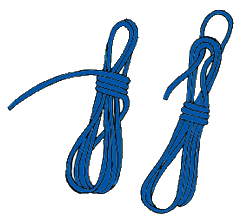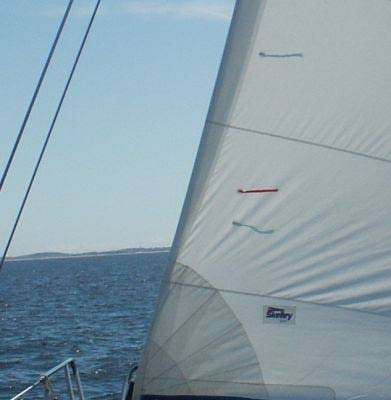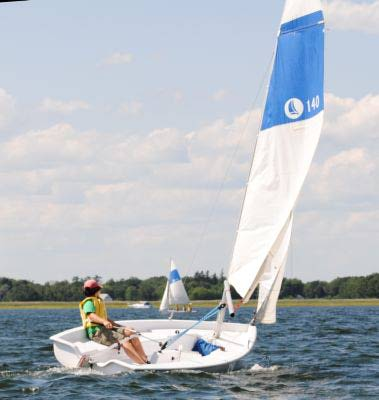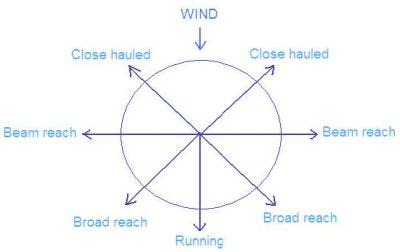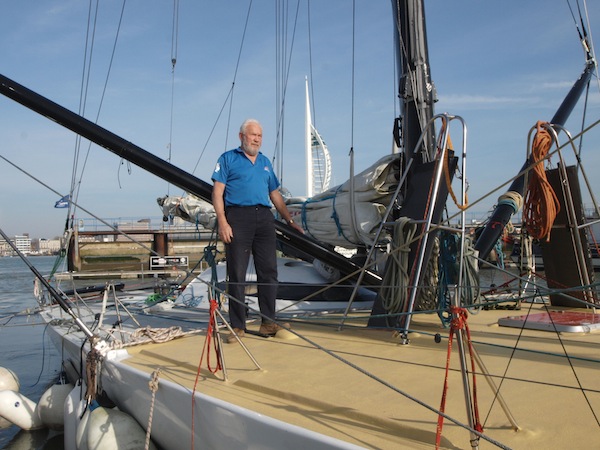Dinghy Sailing
Dinghy sailing is the activity of sailing small boats by using the sails, adjustable centreboard, and tiller. It also involves adjusting the trim and balance by changing position of the crew and helm within the boat. Together with ‘course made good’ (effective choice of route and maneuvers), these are the five essentials of dinghy sailing.
Development of the Dinghy.
There has always been a need for small tender boats as transport to and from moored sailing ships. Together with other smaller work craft such as fishing and light cargo, small inshore craft have always been in evidence. Charles II of England had a private sailing boat presented to him when he returned from exile to England in the 17th century, and he sailed for recreation and competition.
Towards the end of the 19th century people began to use these small boats for sport and recreational sailing, utilising the opportunities for leisure afforded by the industrial revolution. Larger privately used sailing boats had developed separately, and have resulted in the yachts of today. There has been some crossover, in that the sloop sail plan was adopted as standard and most convenient by early dinghy designers.
The development of the sailing dinghy was helped in the early 20th century by Uffa Fox (1898-1972), an English boat designer and sailing enthusiast. He developed and contributed to many dinghy classes which are still with us nearly a century later: the International 14, the Firefly, and the Flying Fifteen.
He also introduced the major advance of hull shapes which can ‘plane’, and which can therefore reach beyond the usual speed limits for small sailing boats. In effect, a boat which is planing is skimming along the surface, rising up on its own bow wave. This results in less friction because of reduced waterline length, reduced displacement (the amount of water needing to be pushed aside by the boat), and reduced ‘wetted area’. The power given by the sails has to overcome less resistance, and therefore speed increases dramatically.
In 1928 Uffa Fox introduced planing to an astonished racing world in his International 14 boat, the Avenger. He gained 52 first places, two seconds and three third places out of 57 race starts that year.
Another advance in dinghy sailing was introduced in the 1930s, when the technique of trapezing was introduced. This involves using the crew to provide more leverage to keep the sails vertical, by hanging outside the boat on a harness and rope attached to the ‘hounds’ or upper mast. As a result the boat is easier to keep upright, and the sails can deliver maximum power most of the time.
Trapezing during a race first appeared in 1934, on the Vagabond sailed by Peter Scott (son of the famous Scott of the Antartic), and John Winter. The owner of the boat, Beecher Moore, of Thames Sailing Club had worked on developing the technique, in discussion with Uffa Fox. Vagabond was spectacularly successful in that race, winning by four minutes.
Sadly, the innovative technique was immediately banned, and received little development until it was reintroduced on the Flying Dutchman class in the early 1960s.
At the beginning of the twenty-first century, dinghy sailing is still a rapidly developing sport. It is losing its image of being expensive, time consuming and exclusive. This is because of the earlier work of pioneers such as Uffa Fox, and through the use of modern designs and techniques such as lighter hull materials (eg, fibreglass and foam sandwich hull construction, which eliminate timeconsuming maintenance of wooden hulls), more responsive sail materials and design, easily transportable boats (many car-toppable), and simpler rigs such as Gennakers instead of more complex Spinnakers. These advances are more economical in time and money, and have greatly extended the appeal of dinghy sailing.
In Britain and Europe the sport has also been considerably advanced by the RYA, the regulatory authority which regulates racing and which provides modular and accredited training courses for leisure and competitive sailing. A basic sailing course can be completed in several days, and participants can be sure that the training is competent and delivered in a safe setting.
Types of Dinghies
Skiffs are generally the fastest type of dinghy. The skiff has a small narrow hull, and is designed to plane in most conditions with the crew trapezing. It has impressive sail areas including a massive foresail, usually a Gennaker. The 18 ft Skiff is one example which usually has a crew of three: another is the Musto Skiff, a singlehander.
Cruising dinghies are designed for leisure and family sailing and are usually more stable than high performance dinghies. This is provided by a ‘chined’ (less rounded) hull, greater displacement, and proportionally smaller sail area. Examples of these are the Wayfarer, the Mirror, and the Laser 16. Sailing these boats can still give much excitement.
Catamarans are fast, high masted and double hulled boats which fall under the definition of dinghy also, usually having adjustable daggerboards. The influential Hobie was developed in America, and this has its keel built into each hull shape. The Tornado is a high performance Olympic class catamaran, not for the fainthearted.
Racing dinghies cover a wide range, and many are descended from Uffa Foxe’s seminal International 14. People often “travel” with their dinghies to international races in famous sailing spots such as Lake Garda in Italy. The International 14 remains a popular racing class, having acquired racks (for trapezing crews) and a gennaker since its original design. The Laser is a single hander whose combination of simplicity, portability and performance has done much to advance dinghy racing and training.
Sports Boats: These classes are larger off-shore racing dinghies which shade off into classes of yachts with fixed keels. Usually they have several crew members as well as the helm. Melges 24 and Laser SB3 are current examples of this type.
Development classes: Most dinghy classes have a fairly fixed layout of sails and hull design, and changes are very infrequent. However, some classes can compete and sail with less rigid definitions and measurements. This encourages experiment which often leads to innovation in techniques and construction. Examples are the International 14, the International Moth, and the 18ft Skiff. Classes which are not development classes are usually referred to as “One design”. The first one design was the Water Wag, which first sailed in Dublin Bay in 1887. The class is still sailed today, over a hundred years later.
Organisation of Dinghy Racing
An International Sport
Saiing dinghy racing comes under the auspices of the International Sailing Federation, ISAF http://www.sailing.org
Sailing dinghies compete on an international, national, state, association, club and class basis, using the ISAF International Rules of Racing.
Single Handed or More than One Crew
While many dinghies are single handed (one person only) such as the Laser, many are double handed such as the Heron, Tasar or NS14 and some have more than 2 sailors. Some classes allow children to sail double handed until a particular age and then require them to compete single handed. Some double handed boats are ideal for an adult and child like the Heron, while some such as the Tasar have weight restrictions which ensure they are sailed competitively by two adults or near adults.
One Design or Development Class
Sailing dinghies can be one design, virtually no difference between boats, or development classes like the International Moth which has gone from a wide hulled scow, to a thin hulled skiff and now with a hydrofoil based design competing. Many people prefer one design as it mean the competition is more about sailing ability rather than who can afford the newest innovation, although weight and sail age and quality also come into it even in one design. The people with most chance of winning a regatta often have new sails if not new boats.
An Olympic Sport
Sailing is an Olympic sport in both Mens and Womens divisions and for both yachts and dinghies / skiffs. Olympic dinghy classes include the Laser, 49er, 470 and Europe as well as a particular sailboard.
Racing for All Ages, Sexes and Weights
Most races and regattas are organised based on a class of dinghy, and within the class there may be several divisions such as Masters (older sailors), Heavyweights, Ladies and Juniors.
Handicap Events Mean Anyone Can Win
Results can be compared on a scratch or handicap basis. The most commonly used handicapping system is the back calculated yardstick. Handicaps take into account the results of the sailor over past races, so a heavy person/crew or a female who sails significantly better than previously over a season or regatta can win on handicap.
A Lifetime Sport
Because of the use of handicap events, sailors of any age can be competitive. In the Concord & Ryde Sailing Club in Sydney, New South Wales Australia the youngest crew is 5, the youngest skipper is 10 and the oldest crew is 73 and the oldest skipper is 72.
Yardsticks to Compare Across Classes
Results between classes can be compared using a Yardstick which recognises that, for example, a Laser would be expected (based on past results over a variety of regattas) to finish a course in say 1.1 times the base time, while a Heron would be expected to finish the same course in 1.2 times the base time. A 49er (the Olympic skiff class) might be expected to take 0.9 times the base time and an A class Catamaran might be expected to take 0.8 times. on this basis if the Heron sailor took 110 minutes, the Laser sailor took 108 minutes, the 49er took 92 minutes and the A class too 81 minutes, by dividing the elapsed time for each boat by the Yardstick you will see the Heroner won on corrected time.
Class, Association, Club
Clubs geneally have a number of different classes competing on any one day, often sailing the same course at the same time, but with each class starting a few minutes arpart. Keen club sailors join and compete in events with their State and National Associations. Associations generally cater for only one class of boat, but generally have competitors in several divisions.
Examples
1.1. Class: Laser http://www.laser.org/m/_general/default.asp
2. Club: Concord & Ryde Sailing Club http://www.concordrydesailing.org
3. Association: NSW Heron Association: ” class=”external”>http://herons.dinghies.org
Dinghy Construction Methods
Most dingies were originally carvel hulled, that is, made of overlapping planks. After the Second World War plywood, because of its success in building fighter aircraft, and specifically marine ply was used to build boats on a timber frame. As the skills necessary to build a timber framed boat were too demanding for many people another method of construction called stitch and glue was developed. Fibreglass has since become the main method of construction and even classes originally designed as ply on timber such as the Heron are now more usually made of fibreglass/fiberglass. In the quest for reduced weight foam sandwich construction has been adopted where weight limits allow the weight of the boat to be further reduced and exotic materials are often used for masts where design rules permit. Masts and booms have developed from solid timber through aluminium to carbon fibre. Sails have similarly developed with the advent of kevlar and mylar but some class rules exclude certain types of cloth to ensure expense does not become a factor.
Conclusion
Dinghy sailing is a rapidly changing and popular sport all over the world. It has become safer and more accessible over the years.
The sport has a tendency to retain its followers who ‘catch the bug’, but who have not been told about its addictive properties when they started!

